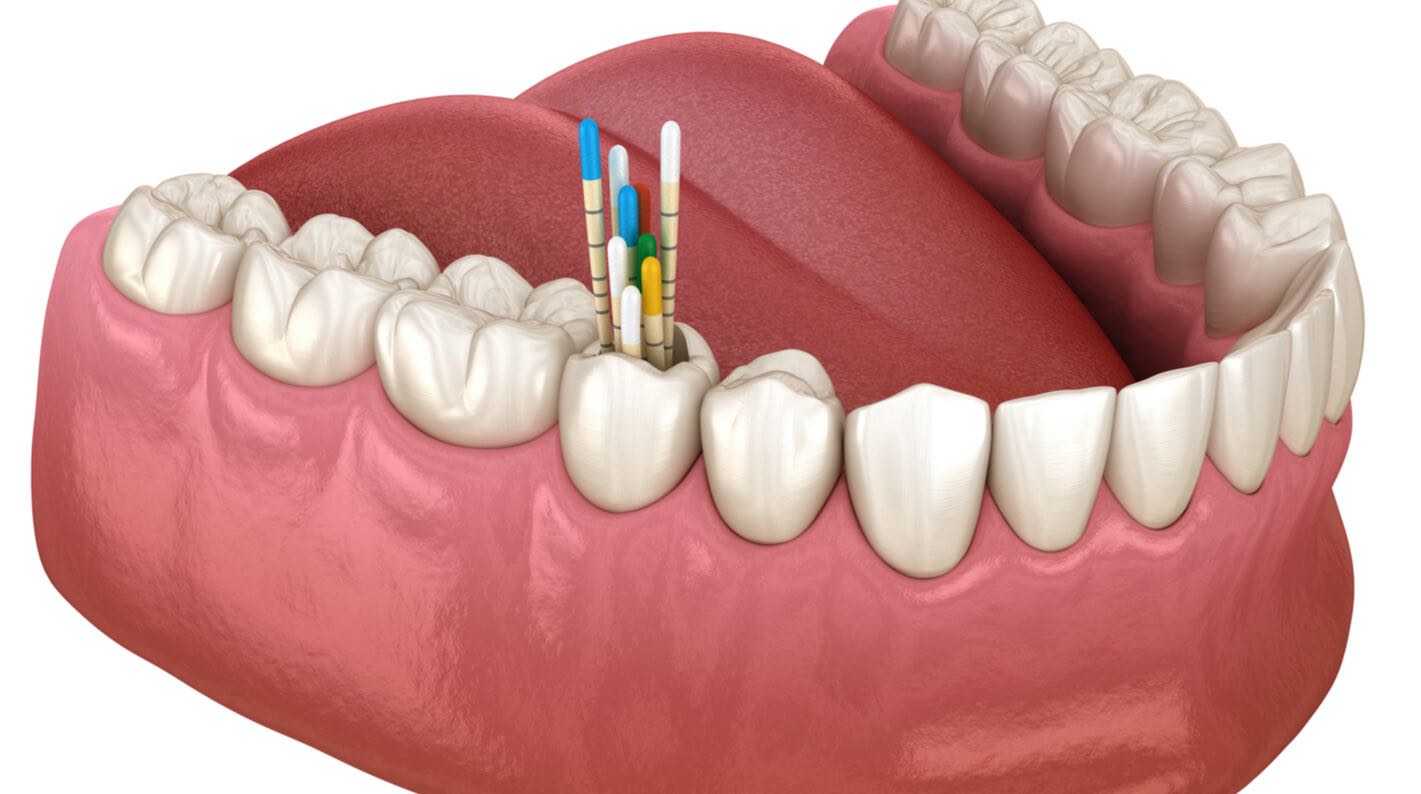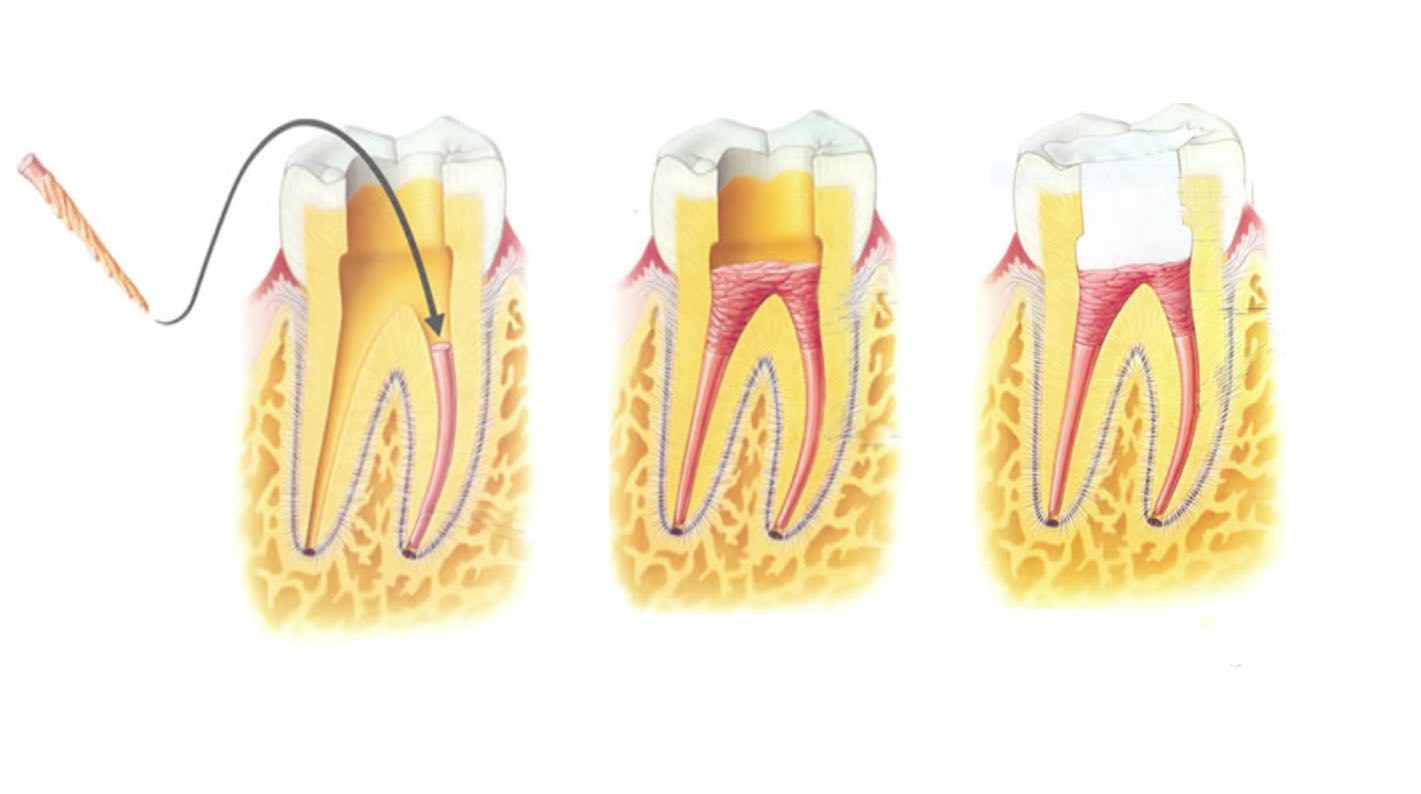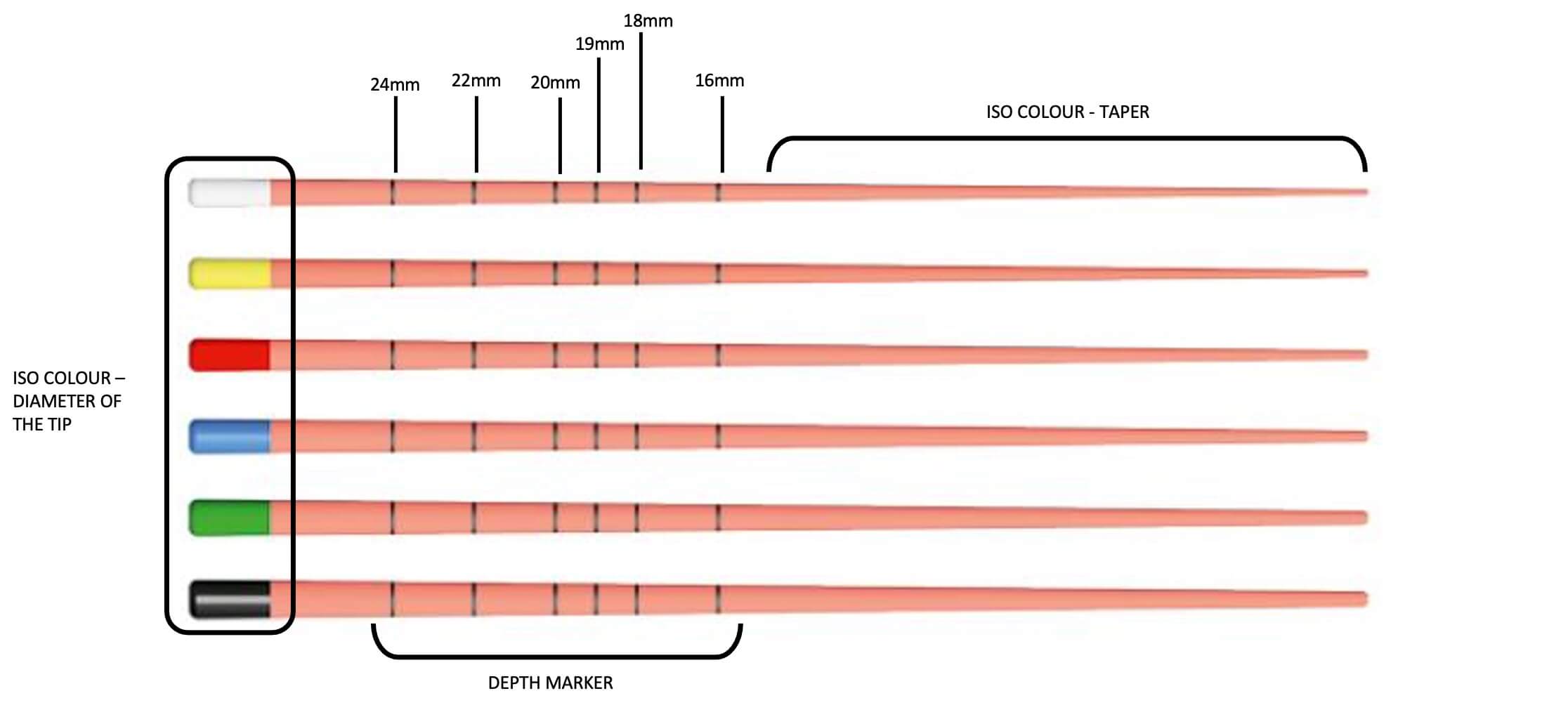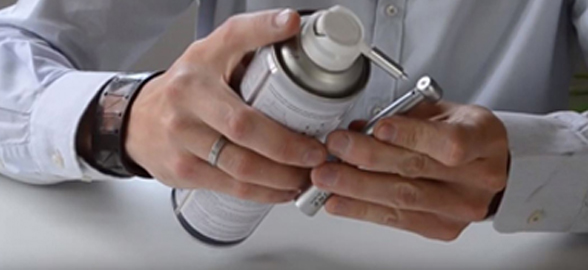Dental gutta-percha was first used in dentistry over 170 years ago by Edwin Maynard, an American endodontist. Despite ongoing research and the search for new innovations in root canal filling methods, gutta-percha remains one of the most successful and widely used options in clinics around the world. This is due to its ability to completely seal a root canal and thus prevent bacteria from entering the area. In other words, a permanent solution is provided for the patient.
It is helpful to understand the origins and composition of this material. Gutta-percha is a natural rubber material obtained from the natural resin of Palaquium trees, native to Southeast Asia. These are cut down, allowed to coagulate, then the rubber-like sap is collected and shaped into bricks for shipping. Gutta-percha is an isomer of polyisoprene in crystalline form with alternating double bonds, and different types of dental gutta-percha can be obtained depending on the attachment and processors used. It has been used in many industries for different purposes, but this article will focus on uses within the dental sector, and more specifically, for root canal fillings.
We also tell you all about the types of gutta-percha and existing classifications. We also introduce you to brands that stand out in the market such as Medicaline, Vidu and Dentsply. Are you ready? Let's get started.

What is Gutta-percha used for in dentistry?
Dental gutta-percha is used for endodontic treatments: it is a flexible and insulating material used for filling the root canal after cleaning. This material is produced in the form of very fine cones, which is known as gutta-percha tips:
- The first gutta-percha tip should be inserted with the same calibre as the last file that has been used to the length of the work.
- This first tip should contain cementitious root canal sealer.
- Once the main gutta-percha tip has been inserted, the sealing is perfectly complemented by adding accessory gutta-percha tips, thus preventing possible leaks inside the canal.
- Finally, the access cavity of the tooth is filled with a protective temporary cement. The function of the gutta-percha has been to hermetically seal the root canal of the tooth correctly.

Why are gutta-percha points so popular in root canal filling procedures?
- First of all, since gutta-percha is a natural material, it has low toxicity. Previously, there were concerns about the cadmium content, a type of metal, in gutta-percha points, but this has been proven false. It is very rare for gutta-percha to contain cadmium as part of its composition, usually any cadmium found in the points is simply a trace from manufacturing methods. Additionally, the FDA allows for safe consumption of 15 µg/g (ppm) in food, and a study by the International Association for Dental Research (IADR) confirmed that gutta-percha points used in endodontics contain an average of 0.10 µg per point, proving the cadmium content does not meet the recommended maximum intake.
- Gutta-percha has also been praised for its low allergic risk. In fact, very few cases of allergic reactions have been reported among patients with latex allergy with the use of gutta-percha; however, it is advisable to discuss this low risk with each patient.
- Due to the composition of gutta-percha points, they are radiopaque and therefore visible on an x-ray. This is vital for endodontists as it allows them to clearly identify how much the gutta-percha point has filled the cavity and to what extent it has been sealed.
- Finally, since gutta-percha points are a rubber-like material, they can be heated and softened. This means that an endodontist could easily remove the gutta-percha points during future procedures.

Are there any disadvantages to using gutta-percha over another method of root canal filling?
Unfortunately, gutta-percha is not an adhesive material. This means that additional cements are needed to fully seal the filling and create an impenetrable barrier. Don't worry! At Dentaltix, we have a category compiled specifically for endodontic sealing cements that contains a wide variety of sealants so you can make sure you are fully equipped for gutta-percha root canal treatment.
Classification of gutta-percha tips
A relevant fact is the lack of organisation among manufacturers with this type of material: there is a great variety of sizes, diameters and surfaces of gutta-percha tips, as well as of heterogeneous industrial chemical compositions, however, not all of them follow ISO standards. By sticking to this classification, we can classify gutta-percha tips as follows:
- Length: the length of dental gutta-percha cones must be greater than 28 mm, although this will always be specified by the manufacturer.
- Conicity: the conicity should be 2% and uniform with the different sizes. Therefore the taper size should be ±0.02 mm.
- Radio-opacity: gutta-percha tips shall have a minimum opacity of 6 mm AL.
In addition, they can also be classified according to the techniques that we will carry out in endodontic treatments with the help of a sealant. The 4 main techniques to be classified are:
- The cold compaction method: lateral condensation of the gutta-percha using digital spacers. It is a simple technique and most canals become sealed.
- Dental gutta-percha coated carrier shank method: stainless steel, titanium, plastic and now also alpha gutta-percha coated gutta-percha shanks, with different tapers depending on the system.
- Thermoplastic dental gutta-percha method: the gutta-percha is softened by heat to obtain a better adaptation of the canal walls.
- Mixed or combined method: combines the cold technique with the thermoplastic technique.
In addition, gutta-percha tips have their own characteristics and advantages such as: biocompatibility, long durability in the tooth, non-staining, waterproof and easy to compact. Incredible, isn't it? Although it is important to note that it is not adhesive and cannot be sterilised chemically or with heat. Even so, it is still the star of endodontic root canal sealing by excellence.
Does the gutta-percha tip depend on the file previously used?
The answer is yes. When endodontic procedures are performed, a hole is created in the tooth up to the pulp chamber and for this purpose, one needs files, where small flexible materials, are used. Each file has a different calibre and the canals are carefully cleaned with these instruments, removing dead pulp. The canals can then be shaped with the appropriate material. This is where our material of the day comes into play: dental gutta-percha. As it is elastic, it produces long, very thin cones that get narrower and narrower, called gutta-percha tips.
When introudcingfirst gutta-percha tip inserted into the canal to be treated must have the same calibre as the last file used to prepare the final part of the cavity or canal.
The two main methods of gutta-percha filling:
Traditionally, the main technique for using gutta-percha in root canal fillings was cold lateral condensation. This method involves physically pressing cold gutta-percha points into the root canal that has been filled and cleaned. A cement is then applied to adhere the gutta-percha to the canal and form a permanent, long-term repair of the empty root canal.
However, since the discovery and use of gutta-percha in dentistry, other developments have occurred. Mainly, thermoplastic gutta-percha for the root canal has been used. This takes advantage of the properties of gutta-percha that allow it to soften and become more adhesive and viscous when heated. This also means that less cement is needed to completely seal the root canal.
Thermoplastic obturation techniques
In dentistry, thermoplastic endodontics consist of three main thermoplastic techniques: McSpadden technique, Hybrid technique and Ultrasonic obturation.
- The McSpadden technique uses compactors, which are standardized stainless steel instruments similar to an inverted Hedstroem file. They are used with the contra-angle at low speed and are based on the principle of reverse rotation to compact the gutta-percha inside the canals.
- Hybrid root canal obturation technique: Ideal for complicated cases, it is especially used for severe curvatures or narrow canals. This technique is very simple and is able to fill irregularities and can correct the obturation, with results almost impossible to achieve with other techniques.
- Ultrasonic obturation technique: This technique offers multiple advantages, since it allows working with the management of the length of the canals, and replicates the three-dimensional shape of the canals adapting to them, heat is generated only during ultrasonic activation, there is a great diversity of tip sizes and these can be pre-curved.
Advantages of the thermoplastic gutta-percha technique
- This technique produces an increase in the density of the gutta-percha in the apical region, avoiding leaks or empty spaces.
- It provides greater fluidity in the lateral canals, filling accessory canals.
- It produces a completely homogeneous mass throughout the canal.
- It has a greater adaptation to dentin.
- Thermoplastic gutta-percha reduces the stress applied to the root.
- Thermoplastic gutta-percha injectable systems of high and low temperature show better results than traditional lateral condensation.
- The dental professional can spend less time working and easier in the treatment of complicated cases due to endodontics performed.
System B obturation system from SybronEndo
Three-dimensional obturation of the properly shaped and prepared root canal is the ideal treatment for root canals, as it prevents microleakage and the passage of microorganisms, making the apical healing process easier. System B is a variation of the vertical condensation technique, as it uses heat but controls it by means of an adjustable device.
It is based on the fluidity of the gutta-percha when it plasticizes rather than on the pressure exerted on the obturating material. That is, this system is based on the continuous transmission of heat to soften the gutta-percha and thus allow it to flow along the root canal, sealing it properly. The System B wave heating system facilitates the compaction of gutta-percha in the apical third. This system handles temperatures of up to 300°C in the spacers and does not exceed 4°C on the external surface of the tooth, so it will not produce any negative effects on the gingival tissues.
How do we identify which type and size of gutta-percha is right for our patients?
First of all, there are two types of gutta-percha: alpha and beta. Alpha is the most commonly used, especially in thermoplastic gutta-percha, as it tends to shrink less and has more viscous and adhesive characteristics when heated, compared to beta, which is used for cold filling techniques, where it is more flexible when cold.
There are a couple of main methods used by manufacturers to distinguish the size and use of gutta-percha points:
- The first of these methods is through an ISO code. You may have seen this form of coding on dental files or burs. The method uses a color code on gutta-percha points to distinguish size. The key measurements of a gutta-percha point in the dental industry are its length, taper, and radiopacity.

The ISO code classifies tips according to the diameter of the head and the size of the taper (for example, an ISO coding of 40/04 means that the diameter of the tip is 0.4 mm and the taper is 0.04 mm per millimeter of the tip). The color of the gutta-percha tip is then a clear identification of its size, making it easier for the dentist in his procedures and avoiding errors or confusion.
The useful part of the ISO coding is that, if used with endodontic files that are also classified by the ISO code, the gutta-percha needed is simply the same as the hole created in the canal by the file. These tips are not only colored by their ISO, but are also marked with fine lines along the tip to help the dentist identify the depth to which the tip has been inserted.
- The other method of grading is gutta-percha tips which are not standardized. These tips are not color-coded or marked at all and are graded simply by size. Typical conventional sizes are extra extra fine (XXF), extra fine (XF), fine (F), medium (M), large (L), and extra large (XL).
At Dentaltix, we have hundreds of gutta-percha products available to fit your needs. Here are our top picks:
You have now reached the end of our blog, we hope it has given you a comprehensive overview of gutta-percha and what it is used for in the dental practice. It is an incredibly useful material for dentists all over the world. If you have any comments or questions, we'd love to hear from you, send us a message through our social media channels or our website and we'll get back to you.
See you next time!





